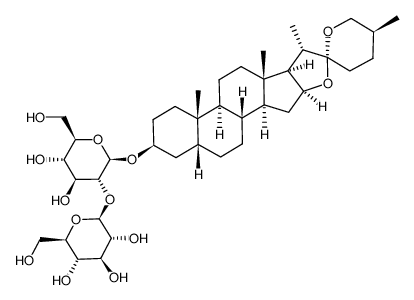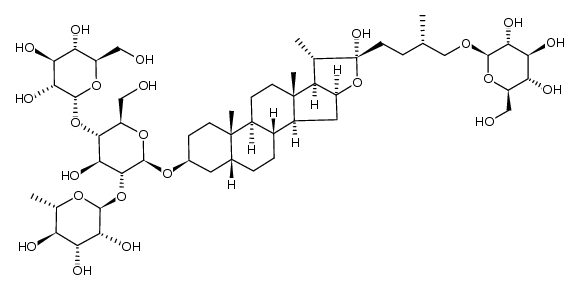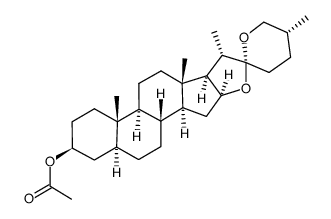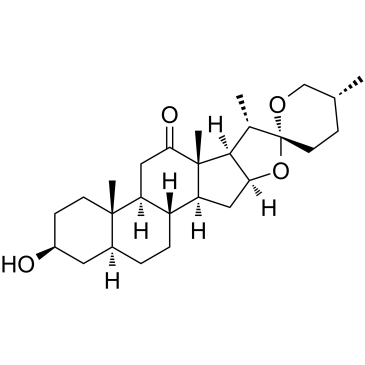126-19-2
| Name | (25S)-5β-spirostan-3β-ol |
|---|---|
| Synonyms |
Spirostan-3-ol, (3β,5β,25S)-
PERIGENIN 5β-Spirostan-3β-ol, (25S)- PARIGENIN MFCD00075412 SARSAPOGENINE EINECS 204-776-3 (2S,4aS,4bS,5'S,6aS,6bR,7S,8R,9aS,10aS,10bR,12aR)-4a,5',6a,7-Tetramethyldocosahydrospiro[naphtho[2',1':4,5]indeno[2,1-b]furan-8,2'-pyran]-2-ol Sasarasapogenin (2S,4aS,4bS,5'S,6aS,6bR,7S,8R,9aS,10aS,10bR,12aR)-4a,5',6a,7-Tétraméthyldocosahydrospiro[naphto[2',1':4,5]indéno[2,1-b]furane-8,2'-pyran]-2-ol (3β,5β,25S)-Spirostan-3-ol Yucca Extract SARSAPOGENIN (25S)-5beta-spirostan-3beta-ol (3b,5b,25S)-Spirostan-3-ol Yucca foam extract sarsagenin Sarsasapogenin (25S)-Spirostan-3β-ol |
| Description | Sarsasapogenin is a sapogenin from the Chinese medical herb Anemarrhena asphodeloides Bunge, with antidiabetic, anti-oxidative, anticancer and anti-inflamatory activities. |
|---|---|
| Related Catalog | |
| Target |
NF-κB |
| In Vitro | Sarsasapogenin (20-80 μM) induces apoptosis via caspase-dependent mitochondrial pathway in heLa cells. Sarsasapogenin also induces apoptosis via the caspase-dependent mitochondrial apoptotic pathway. Sarsasapogenin (60 μM)-induced ROS generation triggers ER stress and mitochondrial dysfunction[1]. Sarsasapogenin potently inhibits NF-κB and MAPK activation, as well as IRAK1, TAK1, and IκBα phosphorylation in LPS-stimulated macrophages. Moreover, Sarsasapogenin inhibits the binding of LPS to macrophage Toll-like receptor 4, and polarization of M2 to M1 macrophages[3]. |
| In Vivo | Sarsasapogenin (20 and 40 mg/kg) significantly restores the sucrose preference deficit induced by olfactory bulbectomy (OB), and increases locomotor activity. Sarsasapogenin groups (20 and 40 mg/kg) have significantly lower immobility times, higher AChE protein expression levels than the OB group. Furthermore, Sarsasapogenin (20 and 40 mg/kg) groups have significantly higher α7-nAChR protein expression, and increases higher α4-nAChR protein expression levels compared to rats in the OB group[2]. Sarsasapogenin (5 or 10 mg/kg, p.o.) inhibits TNBS-induced colon shortening and myeloperoxidase activity in mice, reducing NF-κB activation and interleukin (IL)-1β, tumor necrosis factor (TNF)-α, and IL-6 levels, while simultaneously increasing IL-10[3]. |
| Cell Assay | The effect of Sarsasapogenin on cell viability is measured by the MTT assay method. After exposure to Sarsasapogenin in the absence or presence of Z-VAD-FMK pretreatment for the indicated time, cells in 96-well plates are incubated with MTT. The formazan precipitate is dissolved in 200 μL of dimethyl sulfoxide, and the absorbance at 570 nm is measured using a Benchmark microplate reader. |
| Animal Admin | The mice are randomly divided into 7 groups: normal control, TNBS-induced colitic control groups treated with vehicle, timosaponin AIII (5 or 10 mg/kg), Sarsasapogenin (5 or 10 mg/kg) or sulfasalazine (50 mg/kg). Each group consists of 6 mice. The colitis is induced by the intrarectal injection of 2.5% (w/v) TNBS solution (100 μL, dissolved in 50% ethanol) into the colon of anesthetized mice using a thin round-tip needle equipped with a syringe. The normal group is treated with vehicle alone instead of TNBS and test agents. If the injected TNBS solution is excreted, the mouse is excluded from the experiment. Timosaponin AIII or Sarsasapogenin (5 or 10 mg/kg) or sulfasalazine (50 mg/kg) dissolved in 2% tween 80 are orally administered once a day for 3 days after treatment with TNBS. The mice are killed 18 h after the final administration of test agents. The colon is quickly removed, opened longitudinally, and gently washed by PBS. Macroscopic evaluation of the colitis grade is scored (0, no ulcer and no inflammation; 1, no ulceration and local hyperemia; 2, ulceration with hyperemia; 3, ulceration and inflammation at one site only; 4, two or more sites of ulceration and inflammation; 5, ulceration extending more than 2 cm). The colons are stored at −80°C until used in the experiment for ELISA and immunoblotting. |
| References |
| Density | 1.1±0.1 g/cm3 |
|---|---|
| Boiling Point | 516.6±20.0 °C at 760 mmHg |
| Melting Point | 194°C |
| Molecular Formula | C27H44O3 |
| Molecular Weight | 416.637 |
| Flash Point | 266.2±21.8 °C |
| Exact Mass | 416.329041 |
| PSA | 38.69000 |
| LogP | 6.21 |
| Vapour Pressure | 0.0±3.0 mmHg at 25°C |
| Index of Refraction | 1.552 |
| Personal Protective Equipment | Eyeshields;Gloves;type N95 (US);type P1 (EN143) respirator filter |
|---|---|
| Hazard Codes | T+ |
| RIDADR | NONH for all modes of transport |
| WGK Germany | 3 |
| Precursor 9 | |
|---|---|
| DownStream 0 | |


![(25S)-5β-spirostan-3β-yl-[α-L-rhamnopyranosyl-(1->4)]-β-D-glucopyranoside structure](https://image.chemsrc.com/caspic/278/58881-26-8.png)



![(25S)-5β-spirostan-3β-ol 3-O-α-L-arabinopyranosyl-(1->4)-[β-D-glucopyranosyl-(1->2)]-β-D-glucopyranoside structure](https://image.chemsrc.com/caspic/049/84765-74-2.png)



